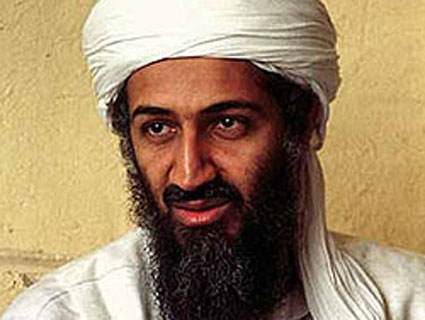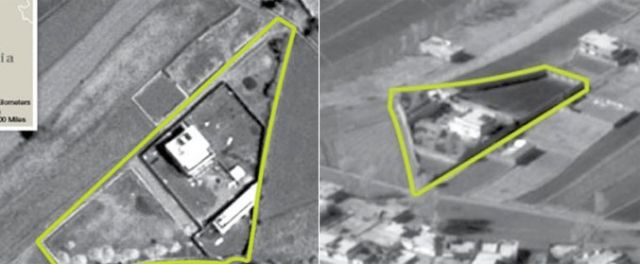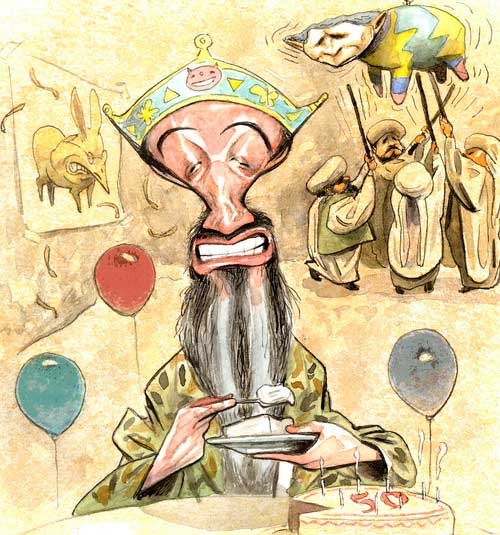
Osama bin Laden, the leader of Al Qaeda and the mastermind of the September 11 attacks, was killed on Sunday in Abbottabad, Pakistan.Photo: FBI
Osama bin Laden, the leader of Al Qaeda and the mastermind of the September 11th attacks, was killed on Sunday in Pakistan. Here’s what we know so far.
Where was Bin Laden killed? He was killed in a “compound near Abbottabad,” which is a relatively wealthy city of about one million people about 150 km north of Pakistan’s capital of Islamabad.
How did he die? The operation was a “surgical strike” by a small US team that entered by helicopter. The team was in the compound for under 40 minutes. Bin Laden was killed in a firefight and US forces took his body with them when they left. Early reports suggested that Bin Laden was shot in the head, but the White House has not confirmed that detail. NBC has reported that he was shot in the left eye. According to ABC, he was shot a second time to make sure he was dead.
Who killed him? In a background briefing, senior administration officials declined to say whether the operation was military or non-military (e.g., CIA). But the buzz elsewhere is that this was a military operation executed by the Naval Special Warfare Development Group (NSWDG or DEVGRU), once known as SEAL Team Six. It’s the special counterterror operations group of the naval special operations community. The SEALS were reportedly under the command of the Joint Special Operations Command and carried out the operation with the help of the CIA. “In all, 79 commandos and a dog were involved in the raid,” according to the New York Times.
Were there eyewitnesses to the raid? Abu Dhabi’s The National newspaper reports that witnesses in Abbottabad awoke around 12:45 am local time on Sunday to the sounds of explosions coming from a house in the suburb of Bilal Town, and saw three helicopters firing on the bin Laden compound. The shooting ended around 2:00 am. “We watched as one of the helicopters was shot down and exploded when it hit the ground,” said Ehtesham-ul-Haq, 30, a businessman who watched from his home.
The National also reports that top members of Al Qaeda and the Afghan Taliban currently hiding out in Pakistan are preparing to flee the country, according to a Karachi-based militant source. “Right now, the priority is safety. All leading figures will be constantly on the move, not staying at one location for more than 15 minutes,” said the source, who added that they will eventually return to Afghanistan.
The Arabic news network Al-Arabiya says bin Laden’s twelve-year-old daughter witnessed his death.
How did we find him? The US began hunting some suspected Bin Laden couriers over four years ago. Eventually, US officials became aware of the compound in Abottabad. The compound was eight times the size of the surrounding houses, and it had huge walls that were so high that people on the third floor still had seven-foot walls shielding them from outside view. The occupants burned all their trash (not a common local practice) and didn’t have any phone or internet access. There were signs that a family matching the size of the Bin Laden clan was living there in secret. The courier who was living there with his brother had no discernible source of income, another tip-off for US intelligence.
Did Bin Laden fight back? Senior administration officials said Bin Laden “resisted” but would not say if he used any weapon in doing so. According to ABC, “Bin Laden himself fired his weapon during the fight” and “was asked to surrender but did not.” White House counterterrorism adviser John Brennan told journalists Monday, “There was a female who was in fact in the line of fire…to shield bin Laden from the gunfire,” adding that it spoke to “the nature of the individual.” But on Wednesday, White House press secretary Jay Carney changed the story, saying that though bin Laden put up a fight, he was unarmed.
How long was he hiding in the compound? The compound was custom-built about five years ago to hide “someone of significance,” according to a senior administration official. Based on the location given by the New York Times, the compound is located less than a mile from the parade ground of the Pakistan Miltary Academy, “Pakistan’s West Point,” whose graduates include former President Pervez Musharraf. (The spot in central Abbottabad identified as “Osama bin Laden’s compound” on Google Maps is not correct.) Here’s video of what could be the compound burning:
And here’s video from ABC News taken inside the compound:
Who knew the raid was coming? The intelligence about the compound was not shared with any other country, including Pakistan. Only a very small number of people within the US government knew of the raid.
How was he able to hide so long undetected? There are good reasons why we didn’t tell the Pakistanis. The New Yorker‘s Steve Coll, a bona fide AfPak/bin Laden expert, has an excellent post on the killing. He says the evidence suggests that “bin Laden was effectively being housed under Pakistani state control.” Read the whole thing.
Was anyone else killed in the raid? No Americans were killed. Three adult males besides Bin Laden were killed in the raid, reportedly including one of Bin Laden’s sons. One woman was killed when she was used as a human shield and another woman was injured. One helicopter was lost to mechanical failure and destroyed on the spot, according to the White House. Given that, this story from the Pakistani newspaper Dawn seems super-interesting. One resident who heard the commotion of the raid tweeted, “A huge window shaking bang here…I hope its [sic] not the start of something nasty.”
Was anyone captured? Early reports suggested that a number of members of bin Laden’s family were captured in the attack. National Journal‘s Marc Ambinder originally reported that a total of 22 people were “captured or killed”—which would indicate that US forces captured as many as 17 people—but he now says 22 people were “counted.” (He says his sources changed their story.)
Where is Bin Laden’s body? A US official says bin Laden’s body has been buried at sea, reports the Associated Press. Politico‘s Mike Allen says the burial happened “less than 12 hours” after bin Laden was killed. CBS News reports that the sea burial occurred after Saudi Arabia refused to take the body. Senior administration officials had promised that his body would be handled according to Islamic practice, which requires a quick burial. “Finding a country willing to accept the remains of the world’s most wanted terrorist would have been difficult, the official said. So the US decided to bury him at sea.” The official did not immediately say where that occurred. The Guardian reports that some Islamic scholars are saying that sea burials are not generally permitted under Islamic law. John Brennan, the president’s top counterterrorism adviser, said in a White House briefing Monday that potential burial scenarios had been weighed and planned for months.
How do we know it was him? Multiple reports say that the US has DNA confirmation.
Wait, we had Bin Laden’s DNA? Actually, according to ABC’s Brian Ross, the US had DNA from Bin Laden’s sister, who died of brain cancer in Boston several years ago.
Are there pictures from the compound? The Pentagon released some in a briefing Monday morning. Here’s a schematic of the compound:

And some aerial shots:

How long has this been planned? President Obama reportedly asked for a plan to take out bin Laden back in June 2009. In August 2010, US intelligence learned about the location of the compound. The attack has been planned for months and the special forces involved practiced extensively. National Journal‘s Yochi Dreazen says that SEALS “built a full-scale mockup of bin Ladin’s compound and spent weeks practicing the raid and learning layout.” Politico‘s Allen says “The SEALs held rehearsals of the raid on April 7 and April 13, with officials monitoring the action from Washington.” Josh Rogin at Foreign Policy and Aamer Madhani at National Journal have each posted a rundown of what was known about the operation as of Sunday night. According to Rogin, the meetings Obama convened with his national security team concerning the operation were held on March 14, March 29, April 12, April 19, and April 28. And Rogin breaks down the the chain of events from over the weekend that led to the final go-ahead:
The final decision to go forward with the operation was made at 8:20 AM on Friday, April 29 in the White House’s Diplomatic Room. In the room at the time were [national security adviser Tom] Donilon, his deputy Denis McDonough, and counterterrorism advisor John Brennan. Donilon prepared the formal orders.
On Sunday, Obama went to play golf in the morning at Andrews Air Force Base. He played 9 holes in chilly, rainy weather and spent a little time on the driving range, as well. Meanwhile, the principals were assembling in the situation room at the White House. They were there from 1:00 PM and stayed put for the rest of the day.
At 2:00, Obama met with the principals back at the White House. At 3:32 he went to the situation room for another briefing. At 3:50 he was told that bin Laden was “tentatively identified.” At 7:01 Obama was told there was a “high probability” the high value target at the compound was bin Laden. At 8:30 Obama got the final briefing.
Before speaking to the nation, Obama called former presidents Bill Clinton and George W. Bush.
Who was in the know during the raid? Allen has the details:
Obama monitored the operation all day from the Situation Room, surrounded by Donilon, White House Chief of Staff Bill Daley, Deputy National Security Adviser Denis McDonough, Secretary of State Clinton, Secretary of Defense Gates, Joint Chiefs of Staff Chairman Mike Mullen, Director of National Intelligence James Clapper, and others. [CIA Director Leon] Panetta was at CIA headquarters, where he had turned his conference room into a command center that gave him constant contact with the tactical leaders of the strike team.
Who’s Bin Laden’s successor? The short answer is: no one. Bin Laden’s number two is Ayman al-Zawahiri, but he does not command the same following or loyalty as the late Al Qaeda leader. According to the New Yorker‘s Lawrence Wright, author of the definitive history of Al Qaeda, Zawahiri “has few of the qualities that would make for a successful leader. He’s anti-charismatic. He ran his own Egyptian terror organization, al-Jihad, into the ground.” Also on the shortlist is Anwar al-Awlaki, the US born cleric who’s now in hiding in Yemen (and who apparently inspired the Underwear bomber and the Fort Hood shooter). But compared to Bin Laden, as Al Qaeda expert Peter Bergen put it on CNN, al-Awlaki’s a “dwarf.”
Are we worried about potential retaliation? US military bases around the world are on high alert in case of retaliation. The government has been preparing for this eventuality for a long time. The US has not heard of any specific retaliation threats against any specific targets. In a statement to agency employees, outgoing CIA director Leon Panetta said: “The terrorists almost certainly will attempt to avenge him, and we must—and will—remain vigilant and resolute.”
What are Islamists/conservatives/active-duty soldiers saying about Bin Laden’s death? Check in with all of them here.
What does former President George W. Bush think? Here’s his statement.
Here’s President Obama’s speech:
Good evening. Tonight, I can report to the American people and to the world that the United States has conducted an operation that killed Osama bin Laden, the leader of al Qaeda, and a terrorist who’s responsible for the murder of thousands of innocent men, women, and children.
It was nearly 10 years ago that a bright September day was darkened by the worst attack on the American people in our history. The images of 9/11 are seared into our national memory — hijacked planes cutting through a cloudless September sky; the Twin Towers collapsing to the ground; black smoke billowing up from the Pentagon; the wreckage of Flight 93 in Shanksville, Pennsylvania, where the actions of heroic citizens saved even more heartbreak and destruction.
And yet we know that the worst images are those that were unseen to the world. The empty seat at the dinner table. Children who were forced to grow up without their mother or their father. Parents who would never know the feeling of their child’s embrace. Nearly 3,000 citizens taken from us, leaving a gaping hole in our hearts.
On September 11, 2001, in our time of grief, the American people came together. We offered our neighbors a hand, and we offered the wounded our blood. We reaffirmed our ties to each other, and our love of community and country. On that day, no matter where we came from, what God we prayed to, or what race or ethnicity we were, we were united as one American family.
We were also united in our resolve to protect our nation and to bring those who committed this vicious attack to justice. We quickly learned that the 9/11 attacks were carried out by al Qaeda — an organization headed by Osama bin Laden, which had openly declared war on the United States and was committed to killing innocents in our country and around the globe. And so we went to war against al Qaeda to protect our citizens, our friends, and our allies.
Over the last 10 years, thanks to the tireless and heroic work of our military and our counterterrorism professionals, we’ve made great strides in that effort. We’ve disrupted terrorist attacks and strengthened our homeland defense. In Afghanistan, we removed the Taliban government, which had given bin Laden and al Qaeda safe haven and support. And around the globe, we worked with our friends and allies to capture or kill scores of al Qaeda terrorists, including several who were a part of the 9/11 plot.
Yet Osama bin Laden avoided capture and escaped across the Afghan border into Pakistan. Meanwhile, al Qaeda continued to operate from along that border and operate through its affiliates across the world.
And so shortly after taking office, I directed Leon Panetta, the director of the CIA, to make the killing or capture of bin Laden the top priority of our war against al Qaeda, even as we continued our broader efforts to disrupt, dismantle, and defeat his network.
Then, last August, after years of painstaking work by our intelligence community, I was briefed on a possible lead to bin Laden. It was far from certain, and it took many months to run this thread to ground. I met repeatedly with my national security team as we developed more information about the possibility that we had located bin Laden hiding within a compound deep inside of Pakistan. And finally, last week, I determined that we had enough intelligence to take action, and authorized an operation to get Osama bin Laden and bring him to justice.
Today, at my direction, the United States launched a targeted operation against that compound in Abbottabad, Pakistan. A small team of Americans carried out the operation with extraordinary courage and capability. No Americans were harmed. They took care to avoid civilian casualties. After a firefight, they killed Osama bin Laden and took custody of his body.
For over two decades, bin Laden has been al Qaeda’s leader and symbol, and has continued to plot attacks against our country and our friends and allies. The death of bin Laden marks the most significant achievement to date in our nation’s effort to defeat al Qaeda.
Yet his death does not mark the end of our effort. There’s no doubt that al Qaeda will continue to pursue attacks against us. We must –- and we will — remain vigilant at home and abroad.
As we do, we must also reaffirm that the United States is not –- and never will be -– at war with Islam. I’ve made clear, just as President Bush did shortly after 9/11, that our war is not against Islam. Bin Laden was not a Muslim leader; he was a mass murderer of Muslims. Indeed, al Qaeda has slaughtered scores of Muslims in many countries, including our own. So his demise should be welcomed by all who believe in peace and human dignity.
Over the years, I’ve repeatedly made clear that we would take action within Pakistan if we knew where bin Laden was. That is what we’ve done. But it’s important to note that our counterterrorism cooperation with Pakistan helped lead us to bin Laden and the compound where he was hiding. Indeed, bin Laden had declared war against Pakistan as well, and ordered attacks against the Pakistani people.
Tonight, I called President Zardari, and my team has also spoken with their Pakistani counterparts. They agree that this is a good and historic day for both of our nations. And going forward, it is essential that Pakistan continue to join us in the fight against al Qaeda and its affiliates.
The American people did not choose this fight. It came to our shores, and started with the senseless slaughter of our citizens. After nearly 10 years of service, struggle, and sacrifice, we know well the costs of war. These efforts weigh on me every time I, as Commander-in-Chief, have to sign a letter to a family that has lost a loved one, or look into the eyes of a service member who’s been gravely wounded.
So Americans understand the costs of war. Yet as a country, we will never tolerate our security being threatened, nor stand idly by when our people have been killed. We will be relentless in defense of our citizens and our friends and allies. We will be true to the values that make us who we are. And on nights like this one, we can say to those families who have lost loved ones to al Qaeda’s terror: Justice has been done.
Tonight, we give thanks to the countless intelligence and counterterrorism professionals who’ve worked tirelessly to achieve this outcome. The American people do not see their work, nor know their names. But tonight, they feel the satisfaction of their work and the result of their pursuit of justice.
We give thanks for the men who carried out this operation, for they exemplify the professionalism, patriotism, and unparalleled courage of those who serve our country. And they are part of a generation that has borne the heaviest share of the burden since that September day.
Finally, let me say to the families who lost loved ones on 9/11 that we have never forgotten your loss, nor wavered in our commitment to see that we do whatever it takes to prevent another attack on our shores.
And tonight, let us think back to the sense of unity that prevailed on 9/11. I know that it has, at times, frayed. Yet today’s achievement is a testament to the greatness of our country and the determination of the American people.
The cause of securing our country is not complete. But tonight, we are once again reminded that America can do whatever we set our mind to. That is the story of our history, whether it’s the pursuit of prosperity for our people, or the struggle for equality for all our citizens; our commitment to stand up for our values abroad, and our sacrifices to make the world a safer place.
Let us remember that we can do these things not just because of wealth or power, but because of who we are: one nation, under God, indivisible, with liberty and justice for all.
Thank you. May God bless you. And may God bless the United States of America.
Here’s a transcript of a background conference call held by senior administration officials just minutes after President Obama’s announcement of Bin Laden’s death. An excerpt:
[W]ithout a doubt, the United States will continue to face terrorist threats. The United States will continue to fight those threats. We have always understood that this fight would be a marathon and not a sprint.
There’s also no doubt that the death of Osama bin Laden marks the single greatest victory in the U.S.-led campaign to disrupt, dismantle, and defeat al Qaeda. It is a major and essential step in bringing about al Qaeda’s eventual destruction.
Bin Laden was al Qaeda’s only (inaudible) commander in its 22-year history, and was largely responsible for the organization’s mystique, its attraction among violent jihadists, and its focus on America as a terrorist target.
The New America Foundation’s Peter Bergen and Steve Coll—who literally wrote the books on the bin Ladens—held a conference call for reporters Monday afternoon. Among the questions asked and topics discussed:
Ultimately, did the policies of the Bush administration deliver bin Laden? Coll remains curious about the extent to which Bush-era interrogation policies bred the intelligence that led to the killing of bin Laden. He pointed out that the information could have come from multiple interrogations of several detainees held at Guantanomo Bay, and that it’s entirely unclear whether any of it came as a result torture. “I suspect we’ll get more clarity about that as time goes along,” Coll speculated.
Where are the pictures? Bergen is convinced that pictures of bin Laden’s dead body exist, and noted that post mortem photos of past high value targets—like Uday and Kusay, the sons of Saddam Hussein—send a commanding message to their allies and enemies alike. Bergen predicted that the pictures will be released eventually.
How does this recast the US’ relationship with Pakistan? In the wake of the Raymond Davis episode, the Pakistani government demanded that the United States withdraw all its covert operatives from within its borders; such an extraction would, inevitably, have substantially weakened the United States’ ability to conduct the sort of unilateral mission that it executed on Sunday.
Coll stressed that there’s much more than meets the eye to the Davis episode, and said that he has a pretty good guess as to what actually went down (but he refuses to speculate until he has more facts). “If what I understand to have taken place took place, it will provide context for this” operation, he said.
But he cautioned against concluding that the Davis affair and the bin Laden raid are in any way causally related. Given that the US was preparing to embark on perhaps its most ambitious secret mission ever, he said, it “makes sense that they would be stubborn about resisting changes in the paradigm” that could have hindered its plans.
Bergen, meanwhile, thinks that the operation “provide[d] a possibility for a reset of this terrible Pakistan/America relationship,” and could result in dialed down drone activity along Pakistan’s border with Afghanistan.







